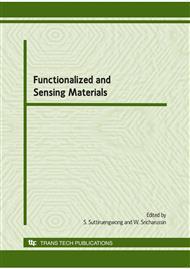p.231
p.235
p.239
p.243
p.247
p.251
p.255
p.259
p.263
Effect of Annealing Ambient on Self-Cleaning Properties of TiO2 Films Prepared by Reactive DC Magnetron Sputtering
Abstract:
Titanium dioxide (TiO2) films were prepared on glass substrates without external heating by DC magnetron reactive sputtering. Argon and oxygen were used as sputtering and reactive gases, respectively. Initially TiO2 films were produced under a constant discharge power of 300W, total operated pressure of 1.10 Pa, the Ar:O2 flow rate of 50:45 sccm and film thickness of 300 nm. After deposition, the films were annealed in air and in vacuum (8×10-1 Pa) at a temperature of 350 °C and an annealed time of 2 hours. Films structure, optical properties, photocatalytic activity (methylene blue degradation) and photo-induced hydrophilicity properties were mainly investigated to produce self-cleaning surface. Because of higher crystallinity of vacuum-annealed films lead to the highest MB degradation under UV irradiation. While, air-annealed films showed lower MB degradation than as-deposited films that could be affected of contamination on surface and defect from annealing. Vacuum-annealed films showed changes of water contact angle on the films surface higher than as-deposited films and air annealed- films.
Info:
Periodical:
Pages:
247-250
Citation:
Online since:
January 2010
Keywords:
Price:
Сopyright:
© 2010 Trans Tech Publications Ltd. All Rights Reserved
Share:
Citation:


